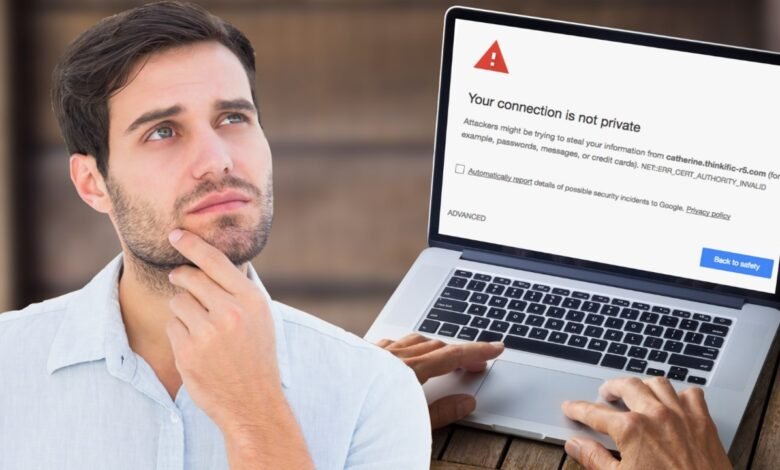Unsecure Page Error: 5 things to try if you get this warning

Encountering an “Unsecure Page Error” all through your on line surfing enjoy can be each alarming and irritating. This warning indicates potential vulnerabilities in the internet site’s protection, raising worries approximately the protection of your non-public records. In present day virtual landscape, wherein cyber threats loom massive, understanding the way to deal with this warning is paramount for safeguarding your on line privateness and protection.
In this article, we will delve into 5 important steps you can take to tackle the “unsecure web page mistakes” efficaciously. By following these pointers, you can mitigate risks, shield your sensitive statistics, and make certain a smoother surfing experience. Whether you are a casual internet user or conducting vital transactions on line, understanding how to reply to this caution is essential for preserving a stable online presence.
Unsecure Page Error
What is an unsecure page error?
An unsecure page error occurs when your web browser detects that the website you’re trying to access does not have a secure connection. It typically manifests as a warning message or an icon in the browser’s address bar, indicating potential security risks.
Why does it occur?
Unsecure page errors can occur due to various reasons, including outdated security protocols, improper website configurations, or the presence of mixed content (i.e., a combination of secure and insecure elements) on the page.
Importance of Website Security
In today’s digital landscape, where cyber threats are rampant, ensuring the security of websites is paramount. Unsecure pages not only pose a risk to users’ sensitive information but also erode trust in the website and its operators.
Impact of unsecure pages on user trust
The impact of unsecure pages on user trust can be significant. When users encounter warnings or indications that a website is not secure, it raises doubts about the reliability and credibility of the site. In today’s digital landscape, where cyber threats abound, users are increasingly cautious about sharing sensitive information online. An unsecure page warning can erode trust in the website and its operators, leading users to question the safety of their personal data. This loss of trust can have far-reaching consequences, affecting user engagement, loyalty, and ultimately, the reputation of the website or business.
Risks associated with unsecure pages
The risks associated with unsecure pages are manifold and pose significant threats to both users and website operators alike. One of the primary risks is the potential exposure of sensitive information to unauthorized parties. Without proper encryption and security measures, data transmitted between the user’s browser and the website server is vulnerable to interception by hackers or malicious entities. This puts user credentials, payment details, and other personal information at risk of being compromised or stolen. Additionally, unsecure pages are susceptible to various cyber attacks, including man-in-the-middle attacks and data breaches, which can result in financial loss, identity theft, and reputational damage. Moreover, unsecure pages may also be targeted for distributing malware or phishing scams, further exacerbating the risks to unsuspecting users.
Understanding Different Types of Unsecure Page Errors
HTTP vs. HTTPS
The primary difference between HTTP and HTTPS lies in their security protocols. HTTP (Hypertext Transfer Protocol) transmits data in plain text, making it susceptible to interception. In contrast, HTTPS (Hypertext Transfer Protocol Secure) encrypts data during transmission, ensuring secure communication between the user’s browser and the website server.
Mixed content warnings
Mixed content warnings occur when a webpage contains a combination of secure (HTTPS) and insecure (HTTP) elements. This can compromise the overall security of the page, triggering unsecure page errors in modern browsers.
Things to Try When You Get an Unsecure Page Error
If you encounter an unsecure page error while browsing the web, here are five steps you can take to address the issue:
Update browser settings
Ensure that your browser is up to date and configured to display secure websites properly. Check for any pending updates and adjust security settings as needed.
Clear browser cache and cookies
Check website URL for errors
To “check website URL for errors” involves verifying the accuracy and correctness of the website address you’re trying to access. Sometimes, errors in the URL, such as typos or misspellings, can lead to unsecure page errors.
Ensure HTTPS configuration
Ensure that the website you’re trying to access is configured with HTTPS encryption. Look for the padlock icon or “https://” prefix in the browser’s address bar to confirm a secure connection.
Disable browser extensions
Best Practices for Website Owners
To prevent unsecure page errors and safeguard user data, website owners should follow these best practices:
Implementing HTTPS
Secure your website by implementing HTTPS encryption protocols. Obtain an SSL/TLS certificate from a trusted certificate authority and configure your web server to use HTTPS by default.
Regular security checks
Perform regular security audits and vulnerability assessments to identify and mitigate potential security risks. Monitor your website’s security posture and promptly address any issues that arise.
Content management system updates
Keep your content management system (CMS) and web server software up to date to ensure compatibility with the latest security protocols and patches. This includes updating plugins, themes, and other third-party components regularly.
Educating users about security measures
Educate your website visitors about the importance of online security and how they can protect themselves from cyber threats. Provide clear instructions on how to verify the security of a website and what steps to take if they encounter unsecure page errors.
Read More: Wealth Management in Germany: Best Practices
Conclusion
Encountering an “unsecure page errors” can be a concerning enjoy, but it is important to address it promptly and effectively. By following the five advocated steps mentioned in this text, you can troubleshoot the caution and mitigate capacity protection dangers. Whether it’s updating your browser settings, clearing cache and cookies, or verifying internet site URLs, taking proactive measures can enhance your online security and protect your sensitive facts.
Remember, prioritizing internet site security is crucial in brand new virtual age, where cyber threats are everyday. By staying informed and implementing pleasant practices, you may navigate the net accurately and expectantly. So, the next time you come upon an “unsecure web page errors,” do not panic. Instead, refer lower back to these steps and take action to make certain a secure browsing experience.
FAQs
Why do some websites still use HTTP instead of HTTPS?
Some websites may still use HTTP due to legacy reasons or budget constraints. However, HTTPS encryption is becoming increasingly important for protecting user data and maintaining trust.
Can I trust a website with an invalid SSL certificate?
It’s not advisable to trust a website with an invalid SSL certificate, as it may indicate a security vulnerability or potential phishing attempt. Always verify the legitimacy of a website before sharing any sensitive information.
Will using a VPN prevent unsecure page errors?
While a VPN can encrypt your internet connection and protect your privacy, it won’t necessarily prevent unsecure page errors. These errors typically occur at the website level due to insecure connections or configurations.
Is it safe to proceed if I ignore an unsecure page warning?
Proceeding despite an unsecure page warning is not recommended, as it may expose you to potential security risks. It’s best to address the issue or find an alternative website with proper security measures in place.
How can I report a website with security issues?
Most modern browsers have built-in mechanisms for reporting security issues, such as phishing or malware. Look for options like “Report Phishing” or “Report Security Issue” in your browser’s settings or help menu.











